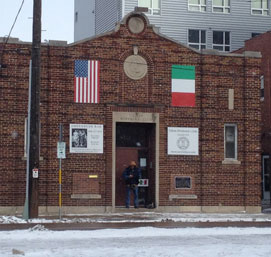Site sponsored by the National Realtors Foundation
They Called It 'Home': A Brief History of Greenbush

"The "Bush" soon became an enclave of cobblers, carpenters and barbers; of bricklayers, painters and common laborers; of grocers, butchers and restaurant owners; and of clubhouses, pool halls and neighborhood taverns."
Catherine Murray "A Taste of Memories"
The Greenbush Neighborhood has been called "Madison's Ellis Island." For a century or more it has been the point of entry for immigrants starting their way on a path of success. This has made it Madison's most diverse neighborhood, a melting pot of vibrant cultures that sometimes blended into wonderful harmony and sometimes clashed in tragic ways.
"African American and Italian boys played sports together on an abandoned lot off of Regent Street, the Jewish proprietor of Novick's grocery store encouraged my great-grandmother to buy food for her family on credit when her husband had missed work due to illness, and very few people locked their doors."
Madison’s first neighborhood center, “Neighborhood House”, was established in 1916 and Columbus Park (now Brittingham Park) was the site of frequent neighborhood picnics on warm summer afternoons. Neighborhood House still thrives, albeit not in the original building, on Mills Street near Regent.
At the time of its founding Neighborhood House was the centerpiece of efforts to help new immigrants adjust to their new, exciting lives as Americans. Neighbors gathered to sew, cook, learn American recipes, speak English and gain citizenship.
The Greenbush Neighborhood was also an early template for today's urban gardens movement. Virtually everyone in the Bush had a garden and when the tomatoes ripened wonderful things happened. To quote Catherine Murray:
“And in the heat of summer’s August, when the tomatoes turned a brilliant red, all the Italian women in the “Bush” would get their tomato boards out of storage in preparation for the making of tomato pastes… and soon the entire neighborhood was fragrant with the aroma of tomatoes, and part of their culture was being preserved.”
And it didn’t stop with tomatoes. Italian immigrants waited for grapes to arrive on the Milwaukee Road trains so that they could be turned into homemade wine.
Unfortunately, the reality of life in Greenbush as experienced by the people who actually lived there was tarnished by perceptions from outside. Woodridge reports that while children of different heritages played well together inside the Bush they were often taunted when they left the neighborhood together. And even a modern day historian continually refers to the old Bush as “a festering slum.”
In part due to this lack of understanding of a complex, imperfect, yet functioning neighborhood by those in power, the Bush was virtually leveled as part of an “urban renewal” project in the 1960’s. Much of the Bush’s grid street pattern was obliterated in favor of the “towers in a park” public housing fashion of the time.
But some of the old Bush survives. The Italian Workmen’s Club (established in 1912) is still there and members still make their own wine. Fraboni’s deli still serves up hot Italian sausage, locally-made Di Salvo’s red sauce and more. Temple Beth Isreal is being refurbished. The Longfellow School, preserved and protected for decades by Meriter Hospital, may soon get a new life as housing.
Now through the Greenbush-Vilas Partnership major institutions in the neighborhood are joining with neighborhood associations, the City of Madison and other partners to bring back the Bush. The urban renewal projects of fifty years ago and the bunker-like buildings along parts of Regent Street are nearing the end of their useful lives. It’s time to reimagine and to reinvest.
We can’t bring back the old Bush. But we can honor its heritage and use its strong foundation to build on. As Catherine Murray writes:
“(Greenbush) was like a rich tapestry of varied colors, with threads interwoven to create a picture and a reminder of an era... And when the tapestry began to fade... no one wanted to brighten its colors... except for the immigrants and their families who so carefully patterned their community from it to make it livable and to call it home.”
By Dave Cieslewicz
Thanks to David Mollenhoff and especially Catherine Murray and Lindsay Woodridge whose works I used as source documents.
